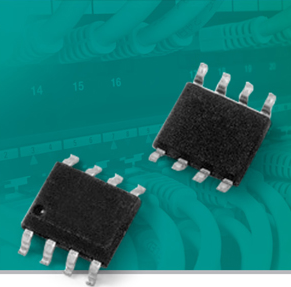Littelfuse , a global leader in circuit protection, today announced the SLVU2.8-8 family of 2.8V, 30A transient suppression diode arrays (SPATM diodes ) designed to protect low voltage CMOS devices from ESD and lightning strikes. State voltage damage is designed. Compared to similar solutions on the market, the SLVU2.8-8 series offers circuit designers a 25% higher power handling capability with a higher electrical safety factor. It also has 57% lower capacitance than other solutions, helping to maintain signal integrity and minimize data loss.

Typical applications for the SLVU2.8-8 family include protection of 10/100/1000 Ethernet devices, WAN/LAN devices, switch systems, desktop computers, servers, notebooks, analog inputs, and base stations.
Tim Micun, product line manager for transient suppression diode arrays, said: "Each low voltage TVS diode has a compensating diode in series to provide a low load capacitance for the protected line. These AEC-Q101 compliant devices are available. Safely absorbs ±30kV of repetitive ESD shock and safely dissipates up to 30A at very low clamping voltages."
All SLVU2.8-8 series of TVS diode arrays have the following important advantages:
• 25% higher power handling capability than comparable market solutions and a higher electrical safety factor.
• Each line has a capacitance of only 2.6pF, which is 57% lower than other solutions, helping to maintain signal integrity and minimize data loss while providing better electrical protection for the device.
• Enhanced ESD protection (±30kV contact discharge, ±30kV air discharge), far above the highest standard of IEC 61000-4-2 (±8kV), providing maximum reliability during installation and use.
The 0.3Ω low dynamic resistance (RDYN) provides the optimum clamping voltage for sensitive chipsets to protect them from catastrophic events for optimal system uptime and reliability.
Availability
The SLVU2.8-8 series is packaged in a small integrated circuit (SOIC) and is available in a tape and reel package with a minimum order quantity of 2,500. Samples are available from authorized Littelfuse distributors around the world. For a list of authorized Littelfuse dealers, visit littelfuse.com.
More information
More information on the SLVU2.8-8 series can be found on its product pages and specifications. If you have technical questions, please contact Tim Micun, Product Manager, Transient Suppression Diode Array, email: .
A prism is a polyhedron made of transparent materials (such as glass, crystal, etc.). It is widely used in optical instruments. Prisms can be divided into several types according to their properties and uses. For example, the "dispersion prism" that decomposes the composite light into the spectrum in a spectroscopic instrument, the more commonly used is an equilateral prism; in a periscope, binocular telescope and other instruments, the direction of light is changed to adjust its imaging position. "Reflecting prisms" generally use right-angle prisms.
Polyhedrons made of transparent materials are important optical elements. The plane where the light enters and exits is called the side, and the plane perpendicular to the side is called the main section. According to the shape of the main section, it can be divided into three prisms, right-angle prisms, pentagonal prisms and so on. The main cross-section of the prism is triangle, and there are two refracting surfaces. The angle between them is called the apex angle, and the plane facing the apex angle is the bottom surface. According to the law of refraction, light passes through a prism and is deflected to the bottom twice. The angle q between the emitted light and the incident light is called the deflection angle. Its size is determined by the refractive index n and the incident angle i of the prism medium. When i is fixed, different wavelengths of light have different deflection angles. Among visible light, the largest deflection angle is purple light, and the smallest is red light.
In modern life, prisms are widely used in digital equipment, science and technology, medical instruments and other fields.
Commonly used digital equipment: cameras, closed-circuit televisions, projectors, digital cameras, digital camcorders, CCD lenses and various optical equipment;
Science and technology: binoculars, microscopes, level gauges, fingerprint meters, gun sights, solar energy converters and various measuring instruments;
Medical equipment: cystoscope, gastroscope and various laser treatment equipment
Optical Prism,Reflecting Prism Beam Splitter Prism,Non-Polarizing Beam Splitter Prism,Roof Prism
Bohr Optics Co.,Ltd , https://www.bohr-optics.com